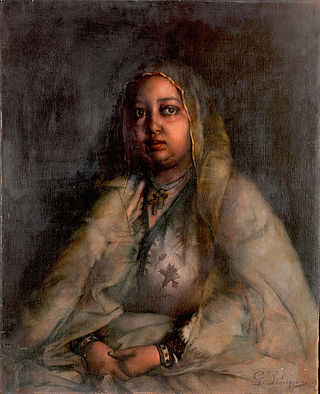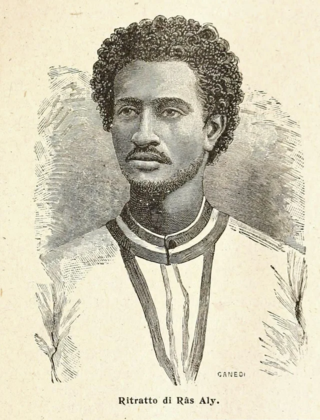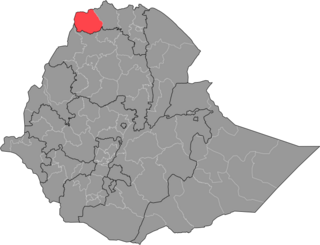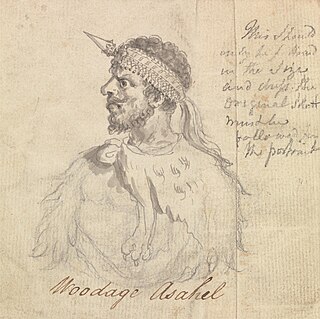Related Research Articles

Taytu Betul was Empress of Ethiopia from 1889 to 1913 and the third wife of Emperor Menelik II. An influential figure in the anti-colonial resistance during the late 19th-century Scramble for Africa, she, along with her husband, founded the modern Ethiopian capital Addis Ababa in 1886.

Tekle Giyorgis I, throne name Feqr Sagad, was Emperor of Ethiopia intermittently between 20 July 1779 and June 1800, and a member of the Solomonic dynasty. He was the youngest son of Yohannes II and Woizoro Sancheviyer, and the brother of Tekle Haymanot II.
Baeda Maryam II was Emperor of Ethiopia from 15 April to December 1795. He may have been the son of Salomon II. Although E. A. Wallis Budge, in his book A History of Ethiopia: Nubia and Abyssinia, notes some authorities believe Baeda Maryam was the same person as Salomon III, Nathaniel Pearce, who met the former Emperor when he visited Ras Wolde Selassie 20 January 1813, states that he had been Emperor only once, for nine months.
Gugsa of Yejju was a Ras of Begemder, and Inderase (regent) of the Emperor of Ethiopia. According to Nathaniel Pearce, he took the Christian name of Wolde Mikael. He was the son of Mersu Barentu and Kefey, the sister of Ras Aligaz. Both Bahru Zewde and Paul B. Henze consider his reign as Ras and Enderase as the peak of the Yejju Dynasty during the Zemene Mesafint.
Yimam of Yejju was a Ras of Begemder and Enderase (regent) of the Emperor of Ethiopia. He was the son of Gugsa of Yejju.

Ali II of Yejju was Ras of Begemder and the de facto ruler of the Ethiopian Empire. He was a member of a powerful Oromo dynasty known as the Yejju, which ruled much of the Ethiopian Empire during the Zemene Mesafint.
Wolde Selassie was Ras of the Tigray province between 1788 and 1816, and Regent of the Ethiopian Empire between 1797 and 1800. John J. Halls, in his Life and Correspondence of Henry Salt, preserves a description of this powerful warlord, as "small in stature, and delicately formed, quick in his manner, with a shrewd expression, and considerable dignity in his deportment." Nathaniel Pearce also notes that Ras Wolde was an avid chess player, and "would play at from morning till night".

Sabagadis Woldu was a governor of Tigray Province of the Ethiopian Empire from 1822 to 1831. Sabagadis gained some notoriety in the first decade of the 19th century for rebelling a number of times against his overlord, Ras Wolde Selassie. But just before the death of Wolde Selassie it seems that he made up with his master and became one of his loyal lieutenants. Following Wolde Selassie's death in 1816, he defied the authority of Wolde Selassie's son, and became the most powerful warlord in Tigray. Making Adigrat his capital, he ruled Tigray and a small strip of the coastal plains of Eritrea by 1818. His rule also extended to the Eritrean highlands.
The Battle of Debre Abbay, also known as the Battle of Mai Islami, was a conflict between Ras Marye of Yejju, regent of the Emperor of Ethiopia, and his rival from Tigray, Dejazmach Sabagadis of Agame. Although Ras Marye lost his life in the battle, Dejazmach Sabagadis was defeated and executed by Ras Marye's followers after surrendering.

The Western Zone is a zone in the Tigray Region of Ethiopia. It is subdivided into three woredas (districts); from north to south they are Kafta Humera, Welkait and Tsegede. The largest town is Humera. The Western Zone is bordered on the east by the North Western Zone, the south by the Amhara Region, the west by Sudan and on the north by Eritrea. Starting from the late 17th C., internal boundaries are clearly shown, with 37 maps displaying a boundary that is located well south of the Tekeze River, or even south of the Simien mountains. Welkait is explicitly included within a larger Tigray confederation ; it is briefly mapped as part of Amhara in 1891-1894 and part of Gondar from 1944-1990. At other periods it appears independent or part of a larger Mezaga lowland region.

The Zemene Mesafint was a period in Ethiopian history between the mid-18th and mid-19th centuries when the country was ruled by a class of Oromo elite noblemen who replaced Habesha nobility in their courts, making the emperor merely a figurehead. For the most part, the regional lords were tightly related by marriage and constituted a stable ruling elite that prevailed until the mid-20th century. In short, during the Zemene Mesafint, the emperors from the Solomonic dynasty were reduced to little more than figureheads confined to the capital city of Gondar.
Enderta or Inderta is a former historical province of Ethiopia; it is located in the eastern edge of the Tigray highlands. Enderta is bordered on the west by Tembien, on the south and southwest by Lasta and Wag, on the east by denkel, and on the north by Agame and Adwa. Mekelle was formerly the capital of the province. Enderta's local administration of Denkel/Afar up to the edges of Aseb under its jurisdiction seems to have been highly, interlinked with the operation of the salt trade and its taxation system; the entire tasks of salt caravan organization being the responsibility of the bäalgada, title assumed by the governor of Endärta, since at least the Medieval period.

The Yejju Oromo, also historically known as the Yajju, Edjow or Edjou Galla, are a sub-clan of the Barento branch of Oromo people. They are one of the northernmost communities of Oromo people residing in Ethiopia, along with the Raayyaa.
Ayalew Birru, or Ayyalaw Birru, was an Ethiopian army commander, a patriot, and a cousin of Emperor Haile Selassie I.

Semien Province was a historical province of northwest Ethiopia. According to Manoel De Almeida Semien was bordered on the north-east and north by Tigray and Tselemt, on the east and south by Abergele, and on the west by Wegera. Alexander Murray include Wag as part of Semien.

Wube Haile Maryam of Semien,, also called by his title Dejazmach Wube, Webé; his name is also given in European sources as ‘‘Ubie’’, was one of the major figures of 19th century Ethiopia, during the closing decades of the Zemene Mesafint a period of regional lords vying for power, prestige and territory amid a weakened authority of the emperors.
Gebre Tasfa better known as Gebre of Semien was the governor of Semien, Tsegede, Welkait and Wogera during the late 18th and early 19th century in Ethiopia. He held the title of Ras, and had an unusually long reign spanning 44 years during the tumultuous Zemene Mesafint when lords of each province and district continuously fought each other for supremacy. Ras Gebre was the primary backer of his son-in-law Emperor Tekle Giyorgis I claims to the throne.

Welde Giyorgis Aboye was one of the most prominent Ethiopian generals who spearheaded Emperor Menelik's southward expansion at the close of the 19th century. His fame soared after leading the conquest on the Kingdom of Kaffa as a Ras, and was subsequently appointed as provincial governor of that fief by the Emperor. Welde Giyorgis later became the governor of Begemder. A few months before his death, he was elevated to Negus, of Gondar by Empress Zewditu in 1917, as recognition for his role in deposing Lij Iyasu.
Betul Haile Maryam was a member of the Semien nobility through his paternal line in the Ethiopian Empire.
Welle Betul also known as Wale Betul, Wolie Betul and Wele Bitul, was an Ethiopian military commander under Emperor Menelik II, the ruler of Begemder, and the younger brother of Empress Taytu Betul.
References
- 1 2 3 Uhlig, Siegbert; Bausi, Alessandro; Yimam, Baye, eds. (2003). Encyclopaedia Aethiopica: D-Ha. Wiesbaden: Harrassowitz. p. 1057. ISBN 9783447052382.
- 1 2 Rosenfeld, Chris Prouty (1986). "The background of Taytu Betul Hayle Maryam" . Empress Taytu and Menilek II Ethiopia 1883-1910. Ravens Educational & Development Services. p. 26-43. ISBN 9780932415103.
- 1 2 3 4 Mordechai, Abir (1968). Ethiopia: the Era of the Princes: The Challenge of Islam and Re-unification of the Christian Empire, 1769-1855. London: Longmans, Green. pp. 32–33. ISBN 9780582645172. OCLC 729977710.
- 1 2 Weld-Blundell, Herbert Joseph (1922). The Royal Chronicle of Abbysinia, 1769-1840;. Cambridge University Press. p. 484-485.
- 1 2 Pearce, Nathaniel (2014). "II". The Life and Adventures of Nathaniel Pearce: Written by Himself, during a Residence in Abyssinia from the Years 1810–1819; Together with Mr Coffin's Account of his First Visit to Gondar. Vol. 1. Cambridge: Cambridge University Press. pp. 99–100. ISBN 9781107450516.
- ↑ Pearce, Nathaniel (2014). "XVII". The Life and Adventures of Nathaniel Pearce: Written by Himself, during a Residence in Abyssinia from the Years 1810–1819; Together with Mr Coffin's Account of his First Visit to Gondar. Vol. 2. Cambridge: Cambridge University Press. p. 193. ISBN 9781107450585.
- 1 2 Rosenfeld, Chris Prouty (1979). "EIGHT ETHIOPIAN WOMEN OF THE "ZEMENE MESAFINT" (c. 1769-1855)". Northeast African Studies. 1 (2): 79–81. JSTOR 43660013.
- ↑ Haile, Getatchew (1989). "EMPRESS TAYITU AND THE ETHIOPIAN PROPERTY IN JERUSALEM". Paideuma: Mitteilungen zur Kulturkunde. 35: 76.
- 1 2 3 Akyeampong, Emmanuel Kwaku; Gates, Henry Louis (2012). Dictionary of African biography vol 1-6. Oxford: Oxford University Press. p. 180-181. ISBN 9780195382075.
- ↑ Pearce, Nathaniel (2014). "II". The Life and Adventures of Nathaniel Pearce: Written by Himself, during a Residence in Abyssinia from the Years 1810–1819; Together with Mr Coffin's Account of his First Visit to Gondar. Vol. 1. Cambridge: Cambridge University Press. pp. 112–113. ISBN 9781107450516.
- ↑ Pearce, Nathaniel (2014). "XIX". The Life and Adventures of Nathaniel Pearce: Written by Himself, during a Residence in Abyssinia from the Years 1810–1819; Together with Mr Coffin's Account of his First Visit to Gondar. Vol. 2. Cambridge: Cambridge University Press. p. 239-242. ISBN 9781107450585.
- ↑ Poluha, Eva (2016). Thinking Outside the Box: Essays on the History and (Under)Development of Ethiopia. Xlibris Corporation. p. 68. ISBN 9781514422236.
- ↑ Marcus, Harold G (1994). A History of Ethiopia . University of California Press. pp. 56–57. ISBN 9780520081215.
- ↑ Rosenfeld, Chris Prouty (1986). "The background of Taytu Betul Hayle Maryam". Empress Taytu and Menilek II Ethiopia 1883-1910 . Ravens Educational & Development Services. p. vi. ISBN 9780932415103.